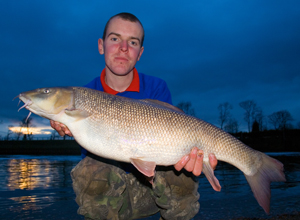 As we neared the end of a recent season I sat down with three of my fellow Don Valley Specimen Group (DVSG) mates and discussed prospects and tactics for the final onslaught. These are the musings of Matt Brown, Lee Swords and Adam Roberts…
As we neared the end of a recent season I sat down with three of my fellow Don Valley Specimen Group (DVSG) mates and discussed prospects and tactics for the final onslaught. These are the musings of Matt Brown, Lee Swords and Adam Roberts…
Bob: Hi guys, only a couple of weeks to go before the season ends. Is there a better time to target a really big barbel?
Lee: Not really, not unless you want to fish illegally! They’re packing on weight, the spawn’s already building up inside them.
Bob (to Adam and Matt): Do You Agree?
Adam: Yes, unless you can target individual fish that you can see in summer.
 Matt: To me, it depends. I’ve sometimes had some serious wash-outs. I’ve really looked forward to the end of the season and then it’s been in flood for two months solid. I can’t get near the river, I can’t keep a lead on the bottom; having said that the fish will probably be out there and feeding. However, if you want to catch the biggest of fish, they are there to be caught. On average, in the final week of the season, there’s no better chance.
Matt: To me, it depends. I’ve sometimes had some serious wash-outs. I’ve really looked forward to the end of the season and then it’s been in flood for two months solid. I can’t get near the river, I can’t keep a lead on the bottom; having said that the fish will probably be out there and feeding. However, if you want to catch the biggest of fish, they are there to be caught. On average, in the final week of the season, there’s no better chance.
Bob: So, where should anglers be fishing, what kind of swims should they be looking for?
Lee: Pre-spawning holding spots have always been good for me in the past. Not eddies, nor out-and-out fast water. The fish always seem to hold up in an area with comfortable flow. I look for swims with about six foot of depth and a good steady pace, the barbel in my opinion are looking at easy feeding as they’re hydrating their eggs . In my experience barbel want to hold up in larger than normal numbers, so I’ll look for a long stretch with 6 foot of depth and a nice steady pace, but saying that, it’s March and everything is dependent on river levels, prevailing  weather and fishing pressure. If a lot of people are coming down to fish you might get a dozen anglers in a row and, if they’re banging leads on top of them, the fish will get cagey or just move altogether. However if the
weather and fishing pressure. If a lot of people are coming down to fish you might get a dozen anglers in a row and, if they’re banging leads on top of them, the fish will get cagey or just move altogether. However if the
weather’s just a little bit on the edge and I can find somewhere that’s nice and
quiet I will be brimming with confidence as you can be in for the fishing session of a lifetime.
Bob: Lee mentioned fish shoaling up in groups. Do you think there’s any difference between where the males and the females go, with obviously the females being your target fish?
Matt: To be honest I haven’t a clue. I’ve read what other people have written and come up with my own theories based on that but I’ve not followed them around or seen any tagging results so I couldn’t really say.
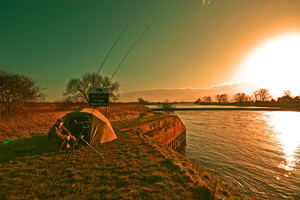 Adam: I think the females generally arrive at the spawning sites first but I don’t think it has much effect in the last weeks of the season, but who knows?
Adam: I think the females generally arrive at the spawning sites first but I don’t think it has much effect in the last weeks of the season, but who knows?
Matt: The general theory is that barbel over-winter in the deeper water before moving up to the weirs and shallower gravel spawning grounds but that would depend on how the winter’s been. A particularly cold winter (like this one) will see them spawning quite late on and this will be well after the season’s finished. You’ve got to go and search the fish out. And if you can find them and start putting the puzzle together, then you have an edge. Always remember that it could be completely different the following year on exactly the same stretch of river. You have to work out the what’s going on each year. When you do have a few clues and put more effort in, the big fish will follow.
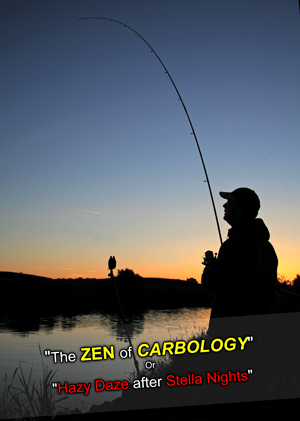 Bob: Are we saying then that if you’re going out in the last couple of weeks of the season and you’re not catching, don’t just sit there, keep moving till you find the fish?
Bob: Are we saying then that if you’re going out in the last couple of weeks of the season and you’re not catching, don’t just sit there, keep moving till you find the fish?
Lee: Definitely, yeah!
Adam: Lee’s already mentioned weather conditions. If the river’s in flood the fish will be in different locations to where they would be at normal levels
Bob: So it’s not science, it’s still about using basic watercraft.
Group: Yes.
Bob: Alright then Matt, what bait will you be using in the last weeks of the season?
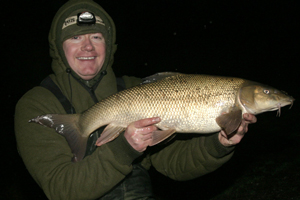 Matt: Erm, again it would depend on the venue and particularly the conditions. I’m a big fan of small baits, almost always unless the river’s in flood. I’ve seen fish spook off big baits in clear water and I’ve caught plenty of barbel using tiny baits with a size 14 hook while other people blank. Fair enough they start catching towards dusk and on through the night but I want to catch during the day as well so the same rules apply throughout the year. The only thing that changes is the amount of bait I feed and this varies with how the fish are feeding.
Matt: Erm, again it would depend on the venue and particularly the conditions. I’m a big fan of small baits, almost always unless the river’s in flood. I’ve seen fish spook off big baits in clear water and I’ve caught plenty of barbel using tiny baits with a size 14 hook while other people blank. Fair enough they start catching towards dusk and on through the night but I want to catch during the day as well so the same rules apply throughout the year. The only thing that changes is the amount of bait I feed and this varies with how the fish are feeding.
Bob: So you’re talking squatts and pinkies?(!)
Matt: (laughing) No, you’ll get too much interference from other species. I’m a particular fan of small pellets.
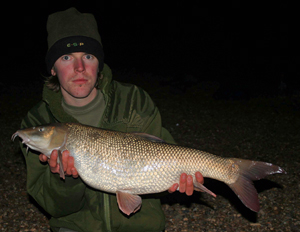 Adam: Like Matt says, it depends on the weather conditions, time of year and time of day, but for me personally it’ll be big baits – big boilies, big lumps of smelly meat to try and single out the biggest fish and avoid the small fish.
Adam: Like Matt says, it depends on the weather conditions, time of year and time of day, but for me personally it’ll be big baits – big boilies, big lumps of smelly meat to try and single out the biggest fish and avoid the small fish.
Lee: I just like to catch ALL the fish. I’m not really bothered if I catch a lot of smaller fish. I like flavoured maggots, glugged maggots over a low food content groundbait – very, very pungent, no food content and fish maggots.
Bob: I’m coming straight back to you there, can you explain glugged and low food value?
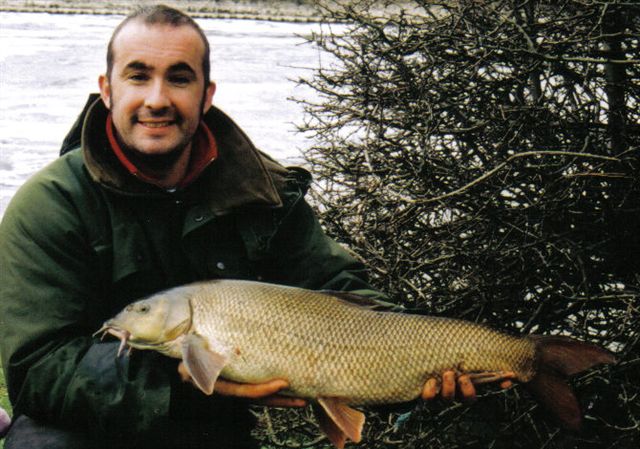 Lee: I use a stick mix that’s got loads of CSL (corn steep liquor) and Activator in it. There’s lots of food signals for them to home in on but there’s nothing for them to eat except a dozen, maybe 15 maggots on a Korda clip. I also tend to use a smallish hook, fluorocarbon hook link during the day, switching to braid at night. But the main bait for me at the tail end of the season is the maggot and they are very, very pungent as I’m glugging with about a teaspoon of lamprey flavour from Teme Severn (Lee’s bait sponsor). Last year Matt and Adam could smell me over 100 yards away…So could the fish…I had 2 11’s and a 12 on my first night!
Lee: I use a stick mix that’s got loads of CSL (corn steep liquor) and Activator in it. There’s lots of food signals for them to home in on but there’s nothing for them to eat except a dozen, maybe 15 maggots on a Korda clip. I also tend to use a smallish hook, fluorocarbon hook link during the day, switching to braid at night. But the main bait for me at the tail end of the season is the maggot and they are very, very pungent as I’m glugging with about a teaspoon of lamprey flavour from Teme Severn (Lee’s bait sponsor). Last year Matt and Adam could smell me over 100 yards away…So could the fish…I had 2 11’s and a 12 on my first night!
Matt: Just expanding on what Lee said, because it’s something I feel really strongly about. Specimen anglers don’t seem to understand food value whereas with match anglers it’s just common knowledge. People tend to talk about a kilo of mix but it depends what’s in it, the size of the particles, how far you spread them out, to determine how long it takes for fish to home in on it and whether they’ll spend a longer time feeding over a greater baited patch and also understanding how your bait is performing under the water is absolutely vital. One little tip I can give you is to fish a single hook bait on the downstream rod, if you are fishing two rods, and put feed in regularly on the top rod. Depending on how the fish are having it I may cast less frequently and try to use a lower food value mix. Even if they’re not having it, say in cold and clear conditions I’ll still fancy my chances of picking up more fish on that downstream rod.
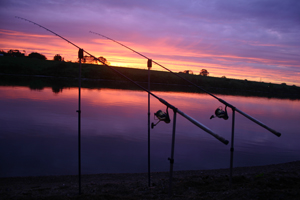 Bob: Is this a good time of the year to be piling bait in or should you be cutting right back on the feed?
Bob: Is this a good time of the year to be piling bait in or should you be cutting right back on the feed?
Adam: Once again it depends on the condition of the river when you’re fishing. If you’re catching fish, and you’re catching numbers, by all means keep the bait going in – you’ve got to hold them there, but if you’re not catching fish you’re not increasing your chances by putting a lot of bait in. It all depends on what the conditions are like when you’re fishing.
Lee: It’s the old matchman’s edict – fish to bites. Just set your stall out to get one bite. When you’ve got that, fish to your next one and like Adam says, if the conditions are right, be quite aggressive, but bear in mind that it is March, it is cold, the fish’s metabolism is quite slow.
Bob: So, is it a case of leaving the bait dropper at home?
Matt: I’ll always take the bait dropper and I’ll always keep the bait in the boot of the car on the grounds that it’s better to have it and not need it, but exactly as Lee said, I’d feed to bites. You can not only ruin your swim but for a number of swims downstream if you put too much bait in and only one or two fish decide to feed, so, I would see how it goes. The skill, really, is working out how to adapt and how to read conditions and to read them as soon as possible.
Bob: Day time or night time?
Lee: Err, dusk! I’ll put a foot in both camps. Hopefully the weather will be nice and settled and the water temperatures will be at their highest in late afternoon. Just on dusk you’ll find the fish go into a nice feeding frenzy and that will go on into the first hour of darkness and as it cools down again the bites will tail off. It’s not like summer when the fish will feed all night – they’re very crepuscular!
Bob: I don’t know what that means! Do you know Adam?
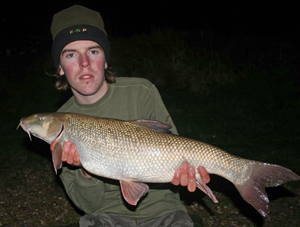 Adam: It sounds a good word but it depends again on river conditions. If it’s up in flood you can catch during the day but if it’s low and clear, like Lee says, you can catch at dusk and first couple of hours of darkness are always best for a bigger fish.
Adam: It sounds a good word but it depends again on river conditions. If it’s up in flood you can catch during the day but if it’s low and clear, like Lee says, you can catch at dusk and first couple of hours of darkness are always best for a bigger fish.
Matt: The common theory is that you catch more in the dark on a low and clear river, particularly if angling pressure is having an influence. Having said that I’ve caught the odd fish during the day, been really, really excited about the dusk period and it’s been a complete anti-climax but then some of the big fish come out and it might have been the only bite you get all night, so you never know. The great thing about fishing is that it really does only take the one bite.
Lee: I’ll second that. You’ve got to be in it to win it.
Bob: So, does anyone have any particular memories from the last week of the season?
Lee: I’ve had some particularly good finishing sessions including a trio of barbel weighing 13lb, 12lb and eleven, a brace of 16lb carp and a 6lb chub. That were fantastic. The year after I struggled for three days. Okay, I had a couple of nice fish, but it is a time I look forward to and I have got the week booked off work.
Adam: Matt and I fished the final week of last season in pretty horrific conditions on the Tidal Trent when most people stayed at home. We had 30 hours when we couldn’t actually fish due to 90-odd mile-an-hour winds blowing our rods off the rod rests but in the end it all came good and we had some pretty good fish.
Matt: It was the harshest conditions I’ve ever fished in. We had a spring tide and, as Adam said, an 80-90 miles an hour wind that was sustained for a couple of days so I just wrapped myself up in the bivvy, reeled the rods in and didn’t come out. I actually thought Adam had been swept out to sea somewhere. It was incredibly harsh and a bit more of an endurance exercise than a fishing trip, however we ended up with some cracking fish. I don’t know how many barbel we caught but my best two fish went twelve and a thirteen pound-odd. Adam did even better.
Adam: Yeah, I had four twelve pounders up to 12lb 14oz and a best fish on the last cast of the last day of 13lb 1oz, and that was again, dusk, just falling dark.
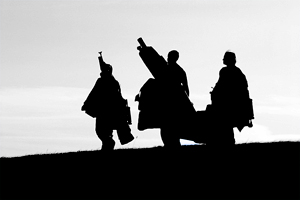 Matt: Most people had gone home because of the conditions and we had the river to ourselves.
Matt: Most people had gone home because of the conditions and we had the river to ourselves.
Adam: Yeah, there were only us two numpties braving it out, but it was worth it.
Bob: I’m not sure I should congratulate you on that…
Matt: But we’re not going to do it again…!
Bob: Well thanks guys, it’s been a pleasure as always.
Footnote: Crepuscular – a term used to describe animals that are primarily active during twilight, that is, at dawn and at dusk.
Click HERE to purchase Barbel Days And Ways DVDs
PAYMENT BY CHEQUE:
If you prefer to pay by cheque or other means you can email Kate Walker at Kali Productions and she will make the neccessary arrangements:
